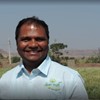This story began about 70 years ago with Mr. Isanrao Dongerdive, great- grandfather of current ED, John Dongerdive. It was in his remote home village that the Good News of Christianity was shared. This village is located in a valley surrounded by mountains. That is why this family is named Dongerdive, which means “lamp on the mountain.” Missionaries from America found this village; and shared with Isanrao the Good News that would eventually affect the entire life of the village. The young man, Isanrao, heard about Jesus Christ and decided to follow him. He did not commit himself fully to the ministry; however, until he had a Damascus-like experience.
His entire village was infected by cholera, a contagious disease spread by contaminated water. Isanrao‘s elder brother, and half of the village died from the disease. One night when Isanrao started experiencing symptoms of cholera, he knew he was also going to die. There was no way he could survive this deadly disease. He knelt down in his village and prayed to the Lord, “God save me, I will give my life to you, and serve you entirely.” His God saved his life. He become well and started praying again for his future life.
As was customary in Indian tradition, he was married as a child. His wife continued to live with her own family until she turned 18. When she became of age, and it was time for her to join Isanrao; her parents found out that their son-in-law had become a follower of Christ, and they called off the marriage. They refused to send their daughter to live with him because he had renounced their traditional Hindu beliefs. Meanwhile, God began to speak to Isanrao's wife in dreams. This new God, unknown to her, kept talking with her; and gave her the strength to make a bold decision to follow Him. She decided to stand against the will of her parents and go with her husband.
This newly wedded couple stared working on their farmland producing grains and vegetables; and in that 50 acres, God started blessing them in every way. But God kept speaking with them; and telling them to “leave their material, worldly treasures, and follow Him and share the Good News with others.” It was difficult to leave their settled life to follow Him. God placed a burden upon his heart for his wife’s home village; the same people who rejected him and threatened to call off his marriage. He and his new wife moved to her village of Changaphale and began sharing the Good News with them. It was extremely difficult. They could not find a home to rent, and people of the village would not let them use water from the common well. When Mr. Dongerdive decided to dig a separate well for the new believers, others contaminated their water with dead animals. The Dongerdives were really praying for this village, and to be able to share the Good News with them. For several years they did not have any success in this village; but this couple kept praying and asking God for His direction. Mr. Dongerdive was able to share with his in-laws first; then,to his wife’s brother; and finally, to others. This is the story of only one generation.
When Mr. Dongerdive decided to follow Christ, his family members and friends wanted him to be a teacher or a farmer so he could make more money, but God kept calling him for His service. He left a lucrative job offer as a teacher, which would have given him all he wanted in his life, and decided to give his life to full-time ministry. He was passionate to make his God known to others in the state of Maharashtra. He was introduced to his future wife; a woman who wanted to marry a missionary and serve the Lord. Perhaps he would not have met her if he would have become a teacher or a farmer. God was calling Pushapa to work among children. She had a degree in teaching and wanted to serve God with a children's ministry. Rawindra and Pushpa both laid the foundation of their dream to serve the people of Maharashtra.
They started an indigenous Christ-centered ministry. This ministry is a true example of an indigenous model of a Christian mission. They had very limited financial and prayer support from outside India; but the sponsors that they did have trusted them implicitly in their strategies and decisions, and they made the ministry grow. It is similar to a New Testament model where evangelism, discipleship, leadership development, and serving the poorest of the poor are the primary focus. The apostle Paul shared the Good News with his counterparts through his letters. Each of his letters written to Asia Minor, Greece, and to the Romans appear different because he has written them to appeal to their individual contexts. He used their core beliefs as a base to build upon; and then, was able to share the Good News with them.
India has a large tradition of missionaries who came from around the world to share the Gospel with the Indian people. The disciple of Christ; St. Thomas, came to India in the first century and started a church in the southern part of India called Kerala. The church that he started still exists. This church has survived the persecution and challenges of thousands of years.











